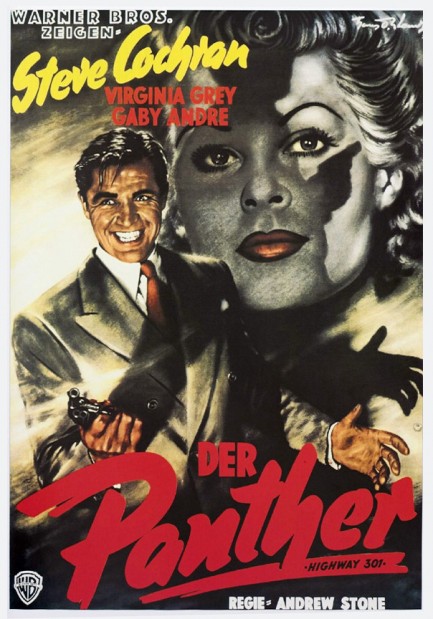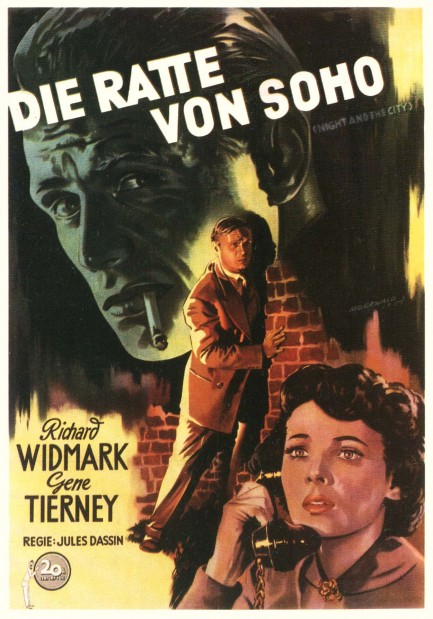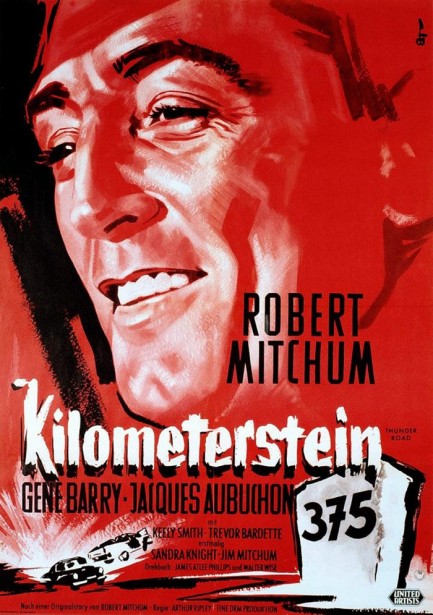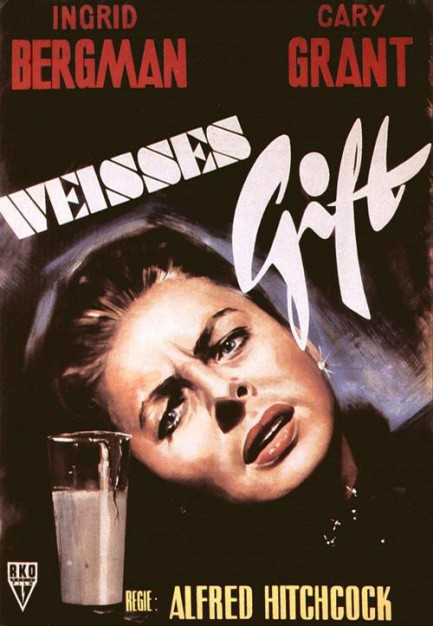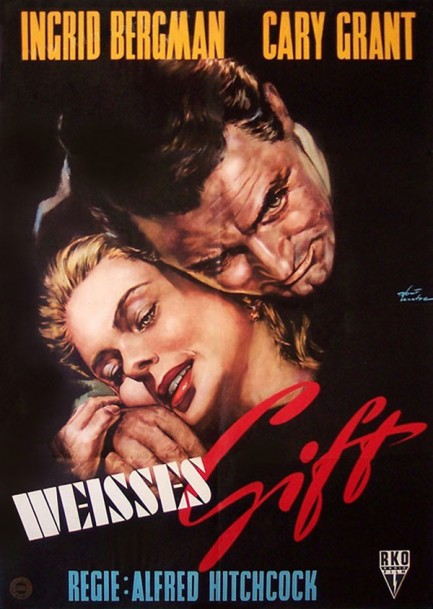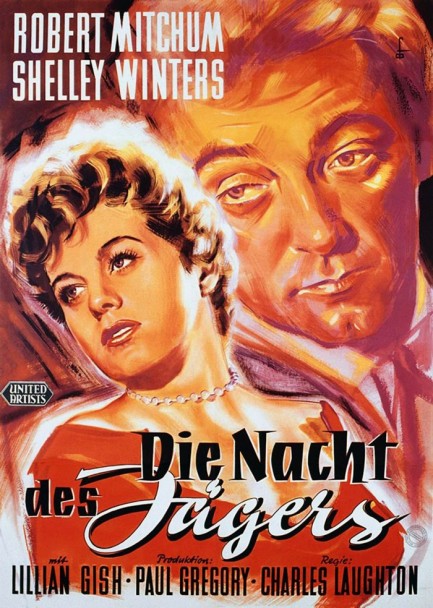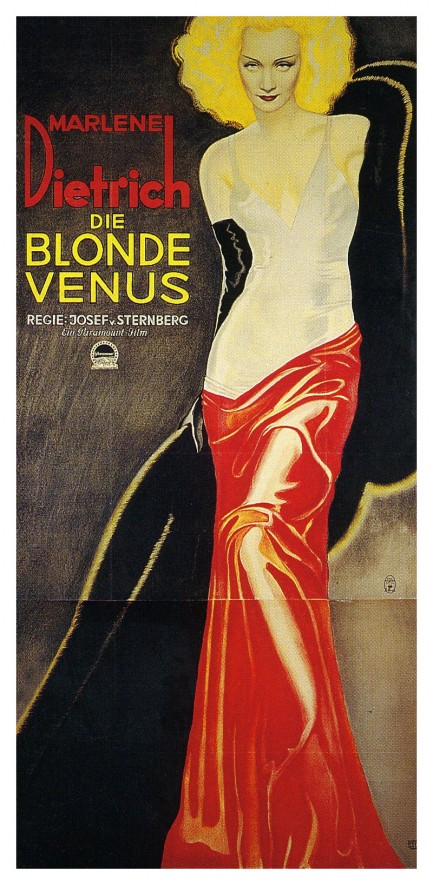 Subway commuters now running to work after latest round of NYC budget cuts eliminates trains. 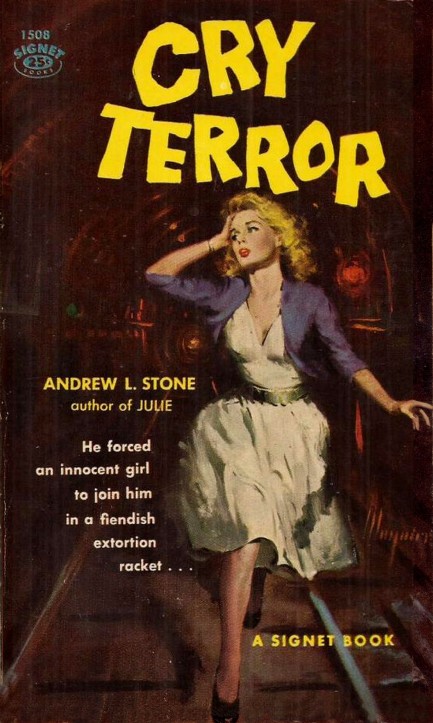
Andrew L. Stone may be unique in the realm of vintage literature. His 1958 thriller Cry Terror is a novelization of the film of the same name, which he wrote, directed, and co-produced. Cry Terror wasn't the first time Stone wore multiple hats. Two years earlier he had written and directed the thriller Julie, and written the novelization too. The screenplay earned him an Academy Award nomination. He racked up thirty-seven directorial credits during his career, and among his output was Stormy Weather, The Hard-Boiled Canary, Highway 301, Confidence Girl, and A Blueprint for Murder. He ended up with a star on the Hollywood Walk of Fame.
Another reason we wanted to highlight Cry Terror today is because of the excellent cover art by Robert Maguire. It was modeled after a promo shot from the film of lead actress Inger Stevens. You see that below. We were thinking about buying the book, but digging up all this info has revealed the entire plot to us, so we won't bother. Also, the copies that are currently out there are going for fifty dollars and up. As we mentioned before, we don't go that high for anything we'd be tempted to swat flies with. Plus we have a ton of books piled up. We may watch the movie, though. Less time, less expense. If we do we'll report back.

 The forecast calls for a slight overcast with a possible hail of bullets. 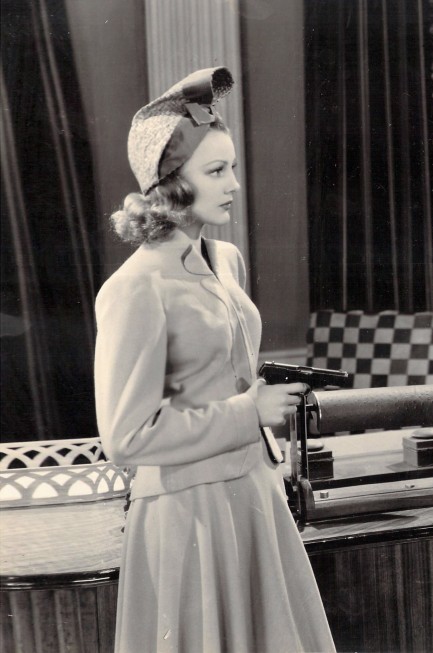
U.S. actress Virginia Grey may not be well known today, but she appeared in a large number of movies, more than ninety by our count, including Another Thin Man, Grand Central Murder, Highway 301, and Mr. and Mrs. North. As she got older she then slid neatly into television roles and racked up probably a hundred credits in that medium as well. The shot above is from 1940 and was made when she was filming The Golden Fleecing with Lew Ayres and Rita Johnson.
 Like an Oreo cookie, the best part of Highway 301 is the stuff in the middle. 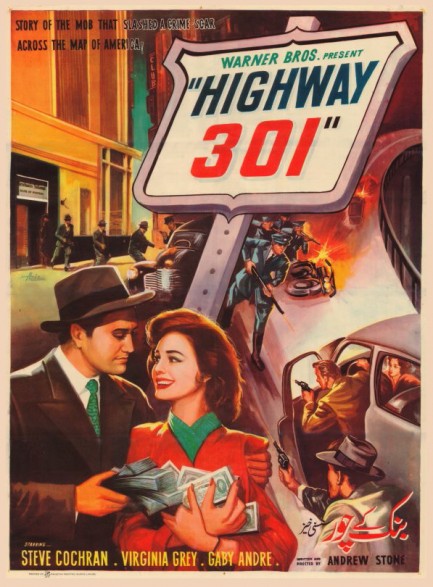
Though we can’t find much online about the making of the 1950 b-budget film noir Highway 301, we have a suspicion what happened during its production. The studio holding the purse strings, Warner Bros., had a look at the rough cut and said there’s no way we’re putting out a movie this intense. How intense is it? Influential New York Times critic Bosley Crowther called it “a straight exercise in low sadism.” So what does a studio do when it has on its hands a movie it thinks is likely to bad vibe audiences right out of the cinema? Simple—tell the audiences before the movie starts how it’s going to end. Get three sitting state governors—W. Kerr Scott of North Carolina, John S. Battle of Virginia, and William P. Lane, Jr. of Maryland—to announce in a prologue that crime does not pay, and that every member of the Tri-State Gang depicted in the movie ended up dead, except for one, who ended up in prison. Was Warner Bros. really responsible for such a blatant mutilation of Highway 301? It’s a very good bet, simply because a screenwriter can’t write a script that counts on the participation of three state governors. But for Jack Warner, well, all it would have taken was a phone call to each. If you pretend the hamfisted prologue never happened, what you end up watching is one of the most underrated and entertaining noirs ever filmed. There are two robberies, a few shootouts, and other action pieces, but the intensity in this film is supplied by its unflinching exploration of the vagaries of fate. Taking an elevator rather than the stairs, choosing to hide rather than run, heading for the back exit rather than the front—it’s decisions such as that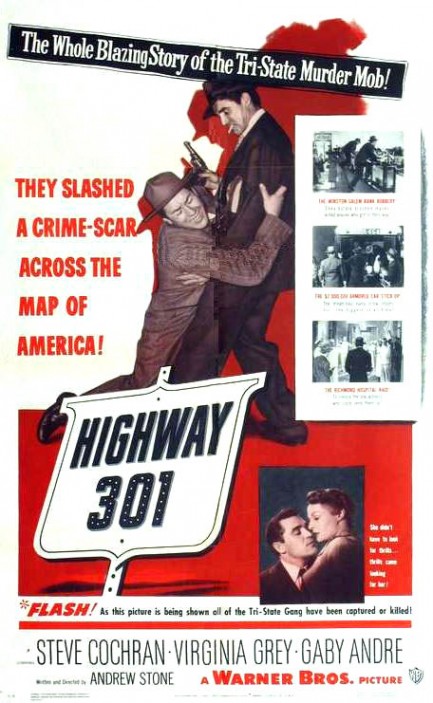 determine the fortunes and misfortunes of the characters, and which gnaw at the nerves of an audience that knows which choice is right but can only watch events unfold. At the center of it all is Steve Cochran as the gang’s murderous leader, a guy who solves every problem with a gun. The supporting cast includes Virginia Grey, Gaby Andre, and Robert Webber, and all are good in their roles. determine the fortunes and misfortunes of the characters, and which gnaw at the nerves of an audience that knows which choice is right but can only watch events unfold. At the center of it all is Steve Cochran as the gang’s murderous leader, a guy who solves every problem with a gun. The supporting cast includes Virginia Grey, Gaby Andre, and Robert Webber, and all are good in their roles. While we know the Tri-State Gang will lose in the end, there’s still plenty of suspense supplied by Gaby Andre’s predicament—she knows too much and the only reason she’s still alive is because Cochran thinks she’s beautiful. But the spell will soon wear off and at that point she’ll be just another dead witness—unless she can escape. Fate continues to intervene. Will it intercede on her behalf? Or against? We know not to anticipate her survival based on her status as the protagonist female. The body count has already told us movie convention is no refuge. That’s the genius of Highway 301—there’s no respite from tension. Every sigh of relief catches in the throat as peril mounts yet again.
Writer/director Andrew L. Stone deserves a lot of credit for putting this together. He was an experienced hand at this point, but never before had he created something so innovative. Highway 301 ends on a down note with more moralizing, but sandwiched in between is a highly recommendable drama. Flawed, yes, but only due to the intrusion of front office types, we suspect. A re-release without the moral parentheses and intermittent narration would elevate this to classic status. The poster at top is classic in its own right. It was painted by someone who signed it Aziz, and the Arabic script in the lower right corner confirms it was made for release in the Middle East or North Africa, most likely Egypt, but don’t quote us on that.
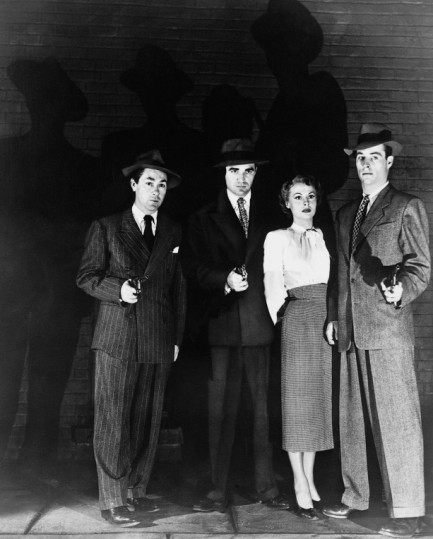 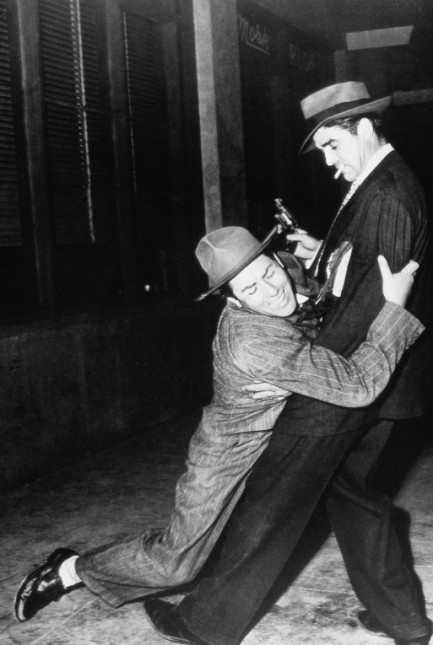 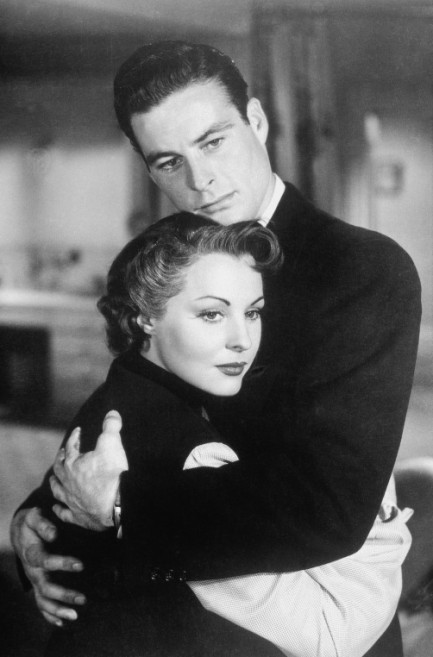 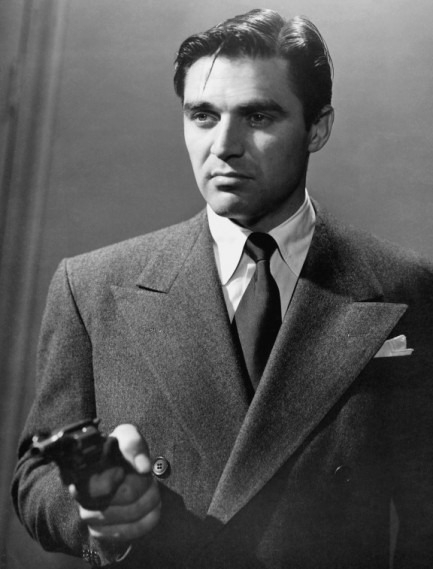 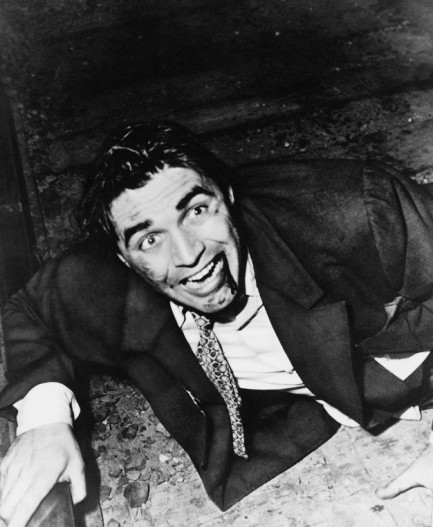
|
 |

The headlines that mattered yesteryear.
2003—Hope Dies
Film legend Bob Hope dies of pneumonia two months after celebrating his 100th birthday. 1945—Churchill Given the Sack
In spite of admiring Winston Churchill as a great wartime leader, Britons elect
Clement Attlee the nation's new prime minister in a sweeping victory for the Labour Party over the Conservatives. 1952—Evita Peron Dies
Eva Duarte de Peron, aka Evita, wife of the president of the Argentine Republic, dies from cancer at age 33. Evita had brought the working classes into a position of political power never witnessed before, but was hated by the nation's powerful military class. She is lain to rest in Milan, Italy in a secret grave under a nun's name, but is eventually returned to Argentina for reburial beside her husband in 1974. 1943—Mussolini Calls It Quits
Italian dictator Benito Mussolini steps down as head of the armed forces and the government. It soon becomes clear that Il Duce did not relinquish power voluntarily, but was forced to resign after former Fascist colleagues turned against him. He is later installed by Germany as leader of the Italian Social Republic in the north of the country, but is killed by partisans in 1945.
|

|
|

It's easy. We have an uploader that makes it a snap. Use it to submit your art, text, header, and subhead. Your post can be funny, serious, or anything in between, as long as it's vintage pulp. You'll get a byline and experience the fleeting pride of free authorship. We'll edit your post for typos, but the rest is up to you. Click here to give us your best shot.

|
|







 determine the fortunes and misfortunes of the characters, and which gnaw at the nerves of an audience that knows which choice is right but can only watch events unfold. At the center of it all is Steve Cochran as the gang’s murderous leader, a guy who solves every problem with a gun. The supporting cast includes Virginia Grey, Gaby Andre, and Robert Webber, and all are good in their roles.
determine the fortunes and misfortunes of the characters, and which gnaw at the nerves of an audience that knows which choice is right but can only watch events unfold. At the center of it all is Steve Cochran as the gang’s murderous leader, a guy who solves every problem with a gun. The supporting cast includes Virginia Grey, Gaby Andre, and Robert Webber, and all are good in their roles.





